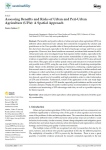Gottero E. (2025). Assessing benefits and risks of urban and peri-urban agriculture (UPA): a spatial approach. Sustainability, 01/06/2025, vol. 17, n. 11, p. 5151.
https://doi.org/10.3390/su17115151
https://doi.org/10.3390/su17115151
| Titre : | Assessing benefits and risks of urban and peri-urban agriculture (UPA): a spatial approach (2025) |
| Auteurs : | E. Gottero |
| Type de document : | Article |
| Dans : | Sustainability (vol. 17, n. 11, June 2025) |
| Article en page(s) : | p. 5151 |
| Langues : | Anglais |
| Langues du résumé : | Anglais |
| Catégories : |
Catégories principales 06 - AGRICULTURE. FORÊTS. PÊCHES ; 6.4 - Production Agricole. Système de ProductionThésaurus IAMM SYSTEME DE PRODUCTION ; AGRICULTURE URBAINE ; AGRICULTURE PERIURBAINE ; EVALUATION ; AVANTAGE COMPARATIF ; RISQUE |
| Résumé : | The benefits and positive effects of urban and peri-urban agriculture (UPA) on different urban dimensions have already been extensively recognized by scholars and practitioners so far. Even possible risks of these professional and non-professional activities have been discussed, especially in the field of landscape ecology and from a social perspective. However, how these benefits are measured, monitored and assessed is still a critical point and a less investigated issue that requires further studies, especially in the research fields that aim to measure and monitor sustainability of urban practices. The evidence on quantitative approaches to estimate benefits and risks of UPA is less advanced than others. This paper aims to define spatial criteria and indicators to evaluate benefits and possible risks of UPA, using the case study of Turin and its bordering municipalities (Italy). Based on the definition and testing of indicators, embracing a spatial approach, this research aims to verify the feasibility of a set of instruments, to define methods and techniques to collect useful data, to test the replicability and transferability of this approach in other urban contexts, as well as to identify its limitations and gaps. Selected indicators showed a good level of versatility and high potential in order to collect information on UPA and its benefits. Furthermore, results of the application on the case study highlighted a significant growth of UPA benefits, especially profit initiatives and the social and economic domains. Finally, the author outlines policy recommendations to improve the evaluation and monitoring of UPA advantages and risks, as well as a possible trajectory for future research. |
| Cote : | En ligne |
| URL / DOI : | https://doi.org/10.3390/su17115151 |







